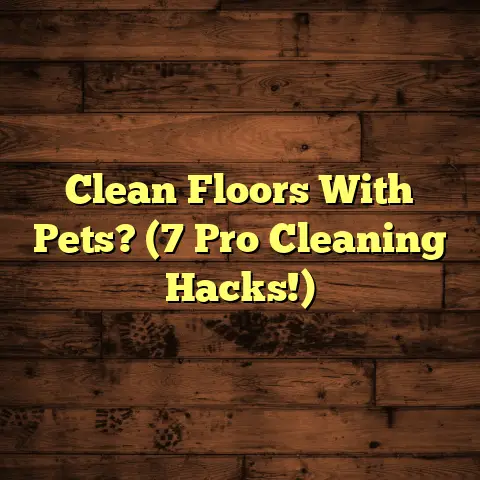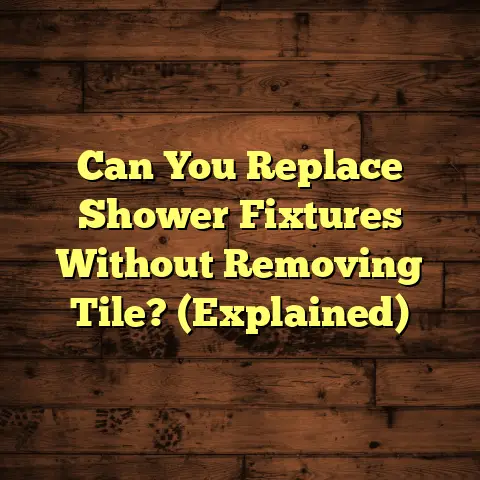Lowes Wood Floor Paint Tips? (9 Pro Coverage Hacks!)
Have you ever looked down at your worn-out wooden floors and wished you could transform them into a fresh, vibrant surface without the expense of a complete overhaul?
I get it. As a flooring contractor for over 15 years, I’ve seen countless homeowners grapple with this very issue. The good news is, you absolutely can! Painting your wood floors is a fantastic DIY project that can breathe new life into your space.
And guess what? You don’t need to break the bank. Let’s dive into my top 9 pro coverage hacks to get those floors looking flawless, all while making the most of what Lowes has to offer.
1. Understanding Wood Floor Paint
So, what exactly is wood floor paint? Simply put, it’s paint specifically formulated to adhere to wood, withstand foot traffic, and resist scuffs and scratches.
Think of it as a protective and decorative coating all in one.
Why Paint Your Wood Floors?
- Aesthetics: Tired of that dated oak? Paint allows you to completely change the color and style of your floors.
- Protection: A good coat of paint acts as a sealant, protecting the wood from moisture and wear.
- Ease of Maintenance: Painted floors are often easier to clean than bare wood, especially if you choose a durable finish.
What Types of Wood Floors Can You Paint?
Most wood floors are paintable, but some are better suited than others.
- Solid Wood: These are your best bet. They’re durable and can be sanded down if needed.
- Engineered Wood: Proceed with caution. Engineered wood has a thin veneer of real wood over a core, so you can’t sand it too aggressively. Always test a small, inconspicuous area first.
- Laminate: Technically, laminate isn’t wood, but it can be painted with the right prep and primer. However, keep in mind that paint adhesion can be tricky.
2. Choosing the Right Paint
This is where things get interesting! The type of paint you choose will significantly impact the look and longevity of your painted floors.
Oil-Based vs. Water-Based
This is the classic showdown. Here’s the lowdown:
| Feature | Oil-Based Paint | Water-Based Paint |
|---|---|---|
| Durability | Excellent | Good (especially newer formulations) |
| Dry Time | Longer (up to 24 hours between coats) | Shorter (4-6 hours between coats) |
| VOCs | High (strong odor, requires good ventilation) | Low (less odor, easier cleanup) |
| Finish | Rich, smooth, often self-leveling | Can be slightly less smooth, may require more coats |
| Cleaning | Requires mineral spirits or paint thinner | Soap and water |
| Yellowing | Can yellow over time, especially in lighter colors | Less prone to yellowing |
Source: My personal experience and observations over 15 years as a flooring contractor.
My Take: While oil-based paints offer superior durability, the high VOCs and longer dry times make water-based options increasingly appealing.
Plus, modern water-based floor paints have come a long way in terms of durability.
Factors to Consider
- Durability: How much foot traffic will the floor endure? Choose a paint specifically designed for floors.
- Finish: Matte, satin, or gloss? Matte hides imperfections better, while gloss is easier to clean. Satin is a good compromise.
- Color: Consider the overall aesthetic of your space. Light colors can make a room feel larger, while dark colors add drama.
- Budget: Prices can vary significantly between brands and types of paint.
Lowes’ Lineup
Lowes carries a variety of wood floor paints. Here are a few popular options:
- Valspar Porch & Floor Latex Enamel: A durable, water-based option that’s easy to apply and clean.
- Rust-Oleum RockSolid Home Floor Coating: A two-part epoxy coating that offers exceptional durability.
- INSL-X Sure Step Acrylic Anti-Slip Coating Paint: Ideal for areas where slip-resistance is important, such as kitchens and bathrooms.
Pro Tip: Don’t hesitate to ask a Lowes associate for recommendations. They can help you find the perfect paint for your specific needs and budget.
3. Preparing Your Floors for Painting
Okay, this is crucial. I can’t stress this enough: proper preparation is the key to a long-lasting, beautiful paint job. Skimp on this step, and you’ll regret it.
Step-by-Step Guide
- Clear the Room: Remove all furniture and belongings.
- Clean Thoroughly: Sweep, vacuum, and then scrub the floors with a wood cleaner. Remove any grease, wax, or dirt.
- Repair Damage: Fill any holes or cracks with wood filler. Let it dry completely and sand smooth.
- Sand the Floors: This is essential for creating a surface that the paint can grip. Use a floor sander with medium-grit sandpaper (100-120 grit) to remove the existing finish and create a smooth surface.
- Vacuum Again: Remove all sanding dust. Dust is your enemy!
- Tack Cloth: Wipe down the floors with a tack cloth to pick up any remaining dust.
- Tape: Use painter’s tape to protect baseboards, trim, and any other areas you don’t want to paint.
Important: If your floors have a very glossy finish, you may need to use a chemical deglosser to ensure proper paint adhesion.
4. Gathering the Right Tools and Materials
Having the right tools will make the job easier and produce better results. Here’s what you’ll need:
- Paint: Obviously!
- Primer: Choose a primer specifically designed for wood floors.
- Paint Tray: For holding the paint.
- Paint Roller: A high-quality roller with a short nap (1/4″ – 3/8″) is ideal for smooth surfaces.
- Paint Brush: For cutting in around edges and corners.
- Painter’s Tape: For protecting trim and baseboards.
- Drop Cloths: To protect your furniture and other surfaces from paint splatters.
- Sandpaper: For smoothing out any imperfections.
- Wood Filler: For repairing any holes or cracks.
- Tack Cloth: For removing dust.
- Cleaning Supplies: Wood cleaner, buckets, sponges, etc.
- Safety Gear: Gloves, eye protection, and a respirator (especially if using oil-based paint).
Lowes Shopping List: You can find all of these items at Lowes. Look for brands like Purdy (brushes and rollers), 3M (painter’s tape), and Rust-Oleum (primers and paints).
5. Pro Coverage Hack #1: Prime Your Floors
I can’t emphasize this enough: do not skip the primer! Primer is like the foundation for your paint job. It:
- Improves Adhesion: Primer creates a grippy surface for the paint to adhere to.
- Blocks Stains: Primer can prevent stains from bleeding through the paint.
- Ensures Uniform Color: Primer helps to create a consistent base for the paint, resulting in a more uniform color.
- Seals the Wood: Primer seals the wood, preventing it from absorbing too much paint.
How to Apply Primer
- Stir the Primer: Stir the primer thoroughly to ensure that it’s properly mixed.
- Cut In: Use a brush to apply primer around the edges of the room, along baseboards, and in corners.
- Roll the Primer: Use a roller to apply primer to the rest of the floor. Work in small sections, overlapping each stroke slightly.
- Let it Dry: Allow the primer to dry completely according to the manufacturer’s instructions. This is usually 2-4 hours.
- Lightly Sand: Once the primer is dry, lightly sand it with fine-grit sandpaper (220 grit) to smooth out any imperfections.
- Clean Again: Vacuum and wipe down the floors with a tack cloth to remove any sanding dust.
6. Pro Coverage Hack #2: Use the Right Application Technique
How you apply the paint is just as important as the paint itself.
Rolling vs. Brushing
- Rolling: Use a roller for large, flat surfaces. This will give you the most consistent coverage.
- Brushing: Use a brush for cutting in around edges, corners, and other tight spaces.
Maintaining a Wet Edge
This is key to avoiding lap marks (those unsightly lines where the paint overlaps).
- Work in Small Sections: Don’t try to paint too large of an area at once.
- Overlap Each Stroke: Overlap each stroke of the roller or brush slightly to blend the paint together.
- Keep the Roller or Brush Loaded: Don’t let the roller or brush dry out. Keep it loaded with paint to maintain a wet edge.
7. Pro Coverage Hack #3: Layering for Depth
Think thin, not thick! Multiple thin coats of paint are always better than one thick coat.
Benefits of Thin Coats
- Better Adhesion: Thin coats adhere better to the surface.
- Less Dripping and Sagging: Thick coats are more likely to drip and sag.
- Faster Drying: Thin coats dry faster.
- More Uniform Coverage: Thin coats result in more uniform coverage.
Drying Time Between Coats
Always follow the manufacturer’s instructions for drying time. Generally, you’ll want to wait at least 4-6 hours between coats for water-based paint and 24 hours for oil-based paint.
How to Tell if the Paint is Dry: The paint should be dry to the touch and not feel tacky. You should also be able to lightly sand the surface without the paint peeling or sticking to the sandpaper.
8. Pro Coverage Hack #4: Choosing the Right Finish
The finish you choose will affect both the appearance and the durability of your painted floors.
Finish Options
- Matte: Matte finishes have very little shine. They’re good at hiding imperfections but can be more difficult to clean.
- Satin: Satin finishes have a slight sheen. They’re a good compromise between matte and gloss.
- Semi-Gloss: Semi-gloss finishes have more shine than satin. They’re easier to clean and more durable than matte or satin.
- Gloss: Gloss finishes have the most shine. They’re very easy to clean and very durable, but they also show imperfections more easily.
Choosing the Right Finish
- High-Traffic Areas: For areas that get a lot of foot traffic, such as hallways and kitchens, choose a semi-gloss or gloss finish.
- Low-Traffic Areas: For areas that get less foot traffic, such as bedrooms, you can use a satin or matte finish.
- Bathrooms: Choose a semi-gloss or gloss finish for bathrooms to resist moisture.
9. Pro Coverage Hack #5: Timing Your Project
Believe it or not, the time of year can impact your paint job.
Best Time to Paint
- Temperature: Avoid painting in extreme temperatures (below 50°F or above 90°F). Ideal temperatures are between 60°F and 80°F.
- Humidity: High humidity can slow down drying time. Avoid painting on very humid days.
Planning Around Drying Times
Factor in drying time when planning your project. You’ll need to allow enough time for each coat of paint to dry completely before applying the next coat.
Also, remember that you won’t be able to walk on the floors while the paint is drying, so plan accordingly.
10. Pro Coverage Hack #6: Protecting Your Floors Post-Painting
You’ve painted your floors – congratulations! Now, let’s protect that beautiful new finish.
During the Drying Process
- Keep Pets and Children Away: Prevent paw prints and little footprints by keeping pets and children out of the room until the paint is completely dry.
- Avoid Walking on the Floors: Resist the urge to walk on the floors until the paint is fully cured.
- Ventilate the Room: Open windows and doors to ventilate the room and speed up the drying process.
Long-Term Maintenance
- Use Rugs and Mats: Place rugs and mats in high-traffic areas to protect the paint from wear and tear.
- Clean Regularly: Sweep or vacuum the floors regularly to remove dirt and debris.
- Use a Mild Cleaner: Use a mild, pH-neutral cleaner to clean the floors. Avoid harsh chemicals or abrasive cleaners.
- Touch Up as Needed: Touch up any scratches or chips as soon as possible to prevent them from getting worse.
11. Pro Coverage Hack #7: Dealing with Common Issues
Even with the best preparation, problems can arise. Here’s how to tackle some common issues:
Bubbling
- Cause: Moisture trapped beneath the paint.
- Solution: Scrape off the bubbles, sand the area smooth, and repaint. Make sure the floors are completely dry before painting.
Peeling
- Cause: Poor adhesion.
- Solution: Scrape off the peeling paint, sand the area smooth, prime, and repaint. Make sure the floors are properly prepared before painting.
Uneven Coverage
- Cause: Inconsistent application.
- Solution: Apply another coat of paint, making sure to apply it evenly.
12. Pro Coverage Hack #8: Creative Finishing Touches
Want to take your painted floors to the next level? Get creative!
Stenciling
Use stencils to add patterns or designs to your painted floors. This is a great way to personalize your space.
Borders
Paint a border around the perimeter of the room to add visual interest.
Faux Finishes
Experiment with faux finishes, such as distressing or antiquing, to create a unique look.
13. Pro Coverage Hack #9: When to Seek Professional Help
Sometimes, DIY isn’t the answer. Here are situations where hiring a professional is a good idea:
- Extensive Damage: If your floors have significant damage, such as rot or warping, it’s best to hire a professional to repair them before painting.
- Lack of Experience: If you’re not comfortable with DIY projects, or if you don’t have the time or patience to do the job properly, hiring a professional is a good option.
- Large Projects: If you’re painting a large area, such as an entire house, hiring a professional can save you time and effort.
Choosing a Professional
- Get Referrals: Ask friends, family, or neighbors for referrals.
- Check Reviews: Read online reviews to get an idea of the contractor’s reputation.
- Get Multiple Quotes: Get quotes from multiple contractors before making a decision.
- Check Insurance and Licensing: Make sure the contractor is properly insured and licensed.
Conclusion
Painting your wood floors is a fantastic way to transform your space without breaking the bank. With the right preparation, tools, and techniques, you can achieve professional-looking results.
So, grab your paint, roll up your sleeves, and get ready to unleash your creativity! And remember, Lowes is your one-stop shop for all your flooring project needs.
Now go on and create some floor magic! You got this!





